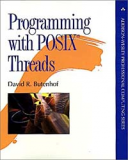Книга: Programming with POSIX® Threads
5.6.1 Many-to-one (user level)
5.6.1 Many-to-one (user level)
The many-to-one method is also sometimes called a "library implementation." In general, "many-to-one" implementations are designed for operating systems with no support for threads. Pthreads implementations that run on generic UNIX kernels usually fall into this category—for example, the classic DCE threads reference implementation, or the SunOS 4.x LWP package (no relation to the Solaris 2.x LWP, which is a kernel entity).
Many-to-one implementations cannot take advantage of parallelism on a multiprocessor, and any blocking system service, for example, a call to read, will block all threads in the process. Some implementations may help you avoid this problem by using features such as UNIX nonblocking I/O, or POSIX.1b asynchronous I/O, where available. However, these features have limitations; for example, not all device drivers support nonblocking I/O, and traditional UNIX disk file system response is usually considered "instantaneous" and will ignore the nonblocking I/O mode.
Some many-to-one implementations may not be tightly integrated with the ANSI C library's support functions, and that can cause serious trouble. The stdio functions, for example, might block the entire process (and all threads) while one thread waits for you to enter a command. Any many-to-one implementation that conforms to the Pthreads standard, however, has gotten around these problems, perhaps by including a special version of stdio and other functions.
When you require concurrency but do not need parallelism, a many-to-one implementation may provide the best thread creation performance, as well as the best context switch performance for voluntary blocking using mutexes and condition variables. It is fast because the Pthreads library saves and restores thread context entirely in user mode. You can, for example, create a lot of threads and block most of them on condition variables (waiting for some external event) very quickly, without involving the kernel at all.
Figure 5.5 shows the mapping ofPthreads threads (left column) to the kernel entity (middle column), which is a process, to physical processors (right column). In this case, the process has four Pthreads threads, labeled "Pthread 1" through "Pthread 4." The Pthreads library schedules the four threads onto the single process in user mode by swapping register state (SP, general registers, and so forth). The library may use a timer to preempt a Pthreads thread that runs too long. The kernel schedules the process onto one of the two physical processors, labeled "processor 1" and "processor 2." The important characteristics of this model are shown in Table 5.2.

FIGURE 5.5 Many-to-one thread mapping
| Advantages | Disadvantages |
| Fastest context switch time. | Potentially long latency during system service blocking. |
| Simple; the implementation may even be (mostly) portable.*[5] | Single-process applications cannot take advantage of multiprocessor hardware. |
TABLE 5.2 Many-to-one thread scheduling
- 5.6.2 One-to-one (kernel level)
- 5.6.3 Many-to-few (two level)
- Chapter 15. Graphical User Interfaces for Iptables
- User-land setup
- Compiling the user-land applications
- User specified chains
- User-land states
- Setting up user specified chains in the filter table
- 9.5.3. Маленький секрет User Agent
- users
- Phone Services
- Part One. “Regulability”




